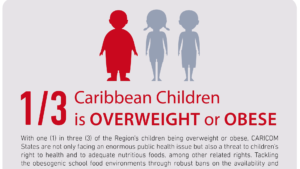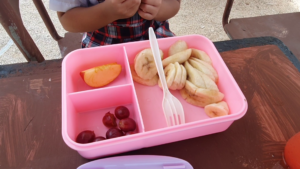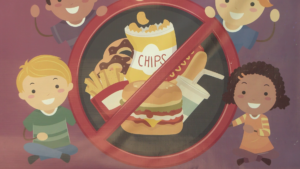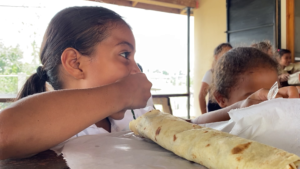Encouraging Children to Consume Healthier Foods
 Today, non-communicable diseases such as heart disease, stroke, or diabetes are the leading causes of illness and premature death in Belize. Multiple risk factors lead to these diseases, such as an unhealthy diet. According to the Pan American Health Organization, the prevalence of obesity in Caribbean children is two to three times higher than in the rest of the world, contributing to the heightened rates of non-communicable diseases. In tonight’s edition of our Five Point Breakdown, we look at the approach to encouraging children to make healthy decisions and the challenges that come with doing so. News Five’s Britney Gordon reports.
Today, non-communicable diseases such as heart disease, stroke, or diabetes are the leading causes of illness and premature death in Belize. Multiple risk factors lead to these diseases, such as an unhealthy diet. According to the Pan American Health Organization, the prevalence of obesity in Caribbean children is two to three times higher than in the rest of the world, contributing to the heightened rates of non-communicable diseases. In tonight’s edition of our Five Point Breakdown, we look at the approach to encouraging children to make healthy decisions and the challenges that come with doing so. News Five’s Britney Gordon reports.
Britney Gordon, Reporting
One in three Caribbean children are overweight or obese. The health of these children will define that of a generation of working adults. If action is not taken swiftly to lead them on a healthier path, these children will continue to be at risk of developing non-communicable diseases, such as hypertension or diabetes; some of the leading causes of death in Belize.
Why healthy eating habits must start at a young age

Robyn Daly-Faber
Robyn Daly-Faber, Nutritionist, MOHW
“Nutrition plays a very big role for growth, for development, for brain development, for proper development of a child’s physical. And also for the prevention of diseases. So I can’t stress the importance of nutrition. But we have to encourage people to know what to feed the child. Because saying healthy foods, what might be healthy in your eyes, might not really be healthy.”
Nutritionist at the Ministry of Health, Robyn Daly-Faber, tells us that obesity is not the only side effect of bad eating habits in children.
 Robyn Daly-Faber
Robyn Daly-Faber
“We have what we call a double burden of malnutrition. A double burden means we have both overnutrition and undernutrition. So overnutrition is looking at obesity and overweight, and undernutrition is looking at stunting and wasting, which is having low height for age and low weight for age. So these are all a result of poor eating habits. And it starts very early, from children under five years old.”
 Across the country, thousands of children reach for a snack at recess, but what are these children eating? Encouraging children to choose healthier food options is an integral part of tackling the issue. At Buttonwood Bay Nazarene Primary School here in Belize City, Standard Six student Jauhn Orozco explains that the decision between what he wants to eat and what he knows he should be eating is a difficult choice.
Across the country, thousands of children reach for a snack at recess, but what are these children eating? Encouraging children to choose healthier food options is an integral part of tackling the issue. At Buttonwood Bay Nazarene Primary School here in Belize City, Standard Six student Jauhn Orozco explains that the decision between what he wants to eat and what he knows he should be eating is a difficult choice.
Why do children prefer junk food?
Britney Gordon
“Why wouldn’t you go for one of maybe a banana or an orange or something like that?”

Jauhn Ororzco
Jauhn Ororzco, Student, Buttonwood Bay Nazarene Primary School
“Because it’s just too tempting to taste the chips.”
Britney Gordon
“Have your parents or your teachers been encouraging you and your classmates to make healthier decisions? “
 Jauhn Orozco
Jauhn Orozco
“Yes, ma’am. They have. They’ve been saying to eat more oranges, and carrots. Because, I went to the eye doctor because I needed the eyeglasses because I’m on the device too much.”
Jauhn enjoys eating fruits and would likely be inclined to choose that as a snack if there was more variety in the servings.
Britney Gordon
“What’s been the hardest part of eating healthier for you?”
 Jauhn Orozco
Jauhn Orozco
“It’s like the vegetables. They don’t really have. That sweet taste you taste in other foods. But I know it’s healthier for me and so I try to eat it as much as possible.”
Britney Gordon
“Which healthy snack is your favorite?”
 Jauhn Orozco
Jauhn Orozco
“Probably the mangos. The mangos with with the hot sauce.”
Britney Gordon
“What do you think they can do to their snack options to make it something that you would want to eat?”
 Jauhn Orozco
Jauhn Orozco
“They could put fruit salads, a mixture of different fruits. Not just selling it, only one fruit. A mixture of different fruits in one.”
For the past two years, Buttonwood Bay Primary School has been part of the Healthy Habits, Healthy Schools, Healthy Belize Campaign. It’s an initiative launched by the Ministry of Health and Wellness to promote better nutrition, physical activity, and hygiene in schools. Also offered to the students is a free feeding program, sponsored by the ministry. Acting Principal, Wendy Smith, says that the children have been receptive to the meals based on the menu options and the way vegetables are incorporated into the servings.
Making nutritious foods accessible to children

Wendy Smith
Wendy Smith, Acting Principal, Buttonwood Bay Nazarene Primary School
“Currently, we offer healthy snacks during break time like watermelon, mangoes, Oranges even cucumbers and the children enjoy that but for lunch, we have been providing different menus for them. Like today, we have black dinner and the infants love black dinner So we have different foods for them. We have rice and beans stew beans. We even had fajitas. We have quesadillas everything differently, but we incorporate the vegetables in them as well.”
Britney Gordon
“And in terms of ensuring that these lunches are also nutritious, don’t have too much salt in them. Is that something that goes into the planning process for these meals?”
 Wendy Smith
Wendy Smith
“Yes, we take workshops. Basically, we have workshops with the cooks and the teachers, and the principal attend these workshops to see more or less what portion to give each child and what is the amount of seasonings and so forth to use on each meal.”
Students may be receptive to healthy feeding programs, however, the challenge lies in ensuring that they choose healthier snacks. Daly-Faber says that this cannot be pushed from one angle, but rather, tackled from all fronts.
 Ensuring Healthier Eating Habits Among Children
Ensuring Healthier Eating Habits Among Children
Robyn Daly-Faber
“One of the challenges that we see is of course, behavior change the willingness to be open to having healthier options in schools. We also see some areas where availability or interference from outside vendors might be a contributing factor. And the willingness of, I would say the openness and the willingness of the school system to openly adapt to it. Because we need to have the entire school community be receptive and positively pushing this. It can’t be only when we promote an activity or a week that we see the change.”
 Malnutrition exists across the Caribbean, which displays some of the highest rates of overweight and obesity in the Americas. To counteract the disparity in children’s nutrition, the Healthy Caribbean Coalition is pushing to implement front-of-package octagonal warning labels on snacks that are high in sodium or sugar to deter consumers from choosing less nutritious options. The initiative has not been implemented into CARICOM legislation, but several Latin American countries have begun adapting labels in compliance with the campaign. Sheena Warner-Edwards, Communications Officer for the HCC, explained the goal of the campaign.
Malnutrition exists across the Caribbean, which displays some of the highest rates of overweight and obesity in the Americas. To counteract the disparity in children’s nutrition, the Healthy Caribbean Coalition is pushing to implement front-of-package octagonal warning labels on snacks that are high in sodium or sugar to deter consumers from choosing less nutritious options. The initiative has not been implemented into CARICOM legislation, but several Latin American countries have begun adapting labels in compliance with the campaign. Sheena Warner-Edwards, Communications Officer for the HCC, explained the goal of the campaign.
A Campaign to target junk food regionally

Sheena Warner-Edwards
Sheena Warner-Edwards, Communications Officer, HCC
“The selection of that particular label that spoke to persons, or that would assist persons in better, choosing or selecting a food that has less salt, we would say, because the label would read heightened. Or, in any case, after that individual purchased the product, they will be able to say about, would I consume this entire package, given it is high in salt? Or would I consume a quarter of the package and leave some for later or another day? So those are the kinds of measures again that the labeling standard would assist persons in doing. You know most people when they’re shopping they don’t have time to necessarily read the back of pack label.”
Britney Gordon for News Five.







Facebook Comments